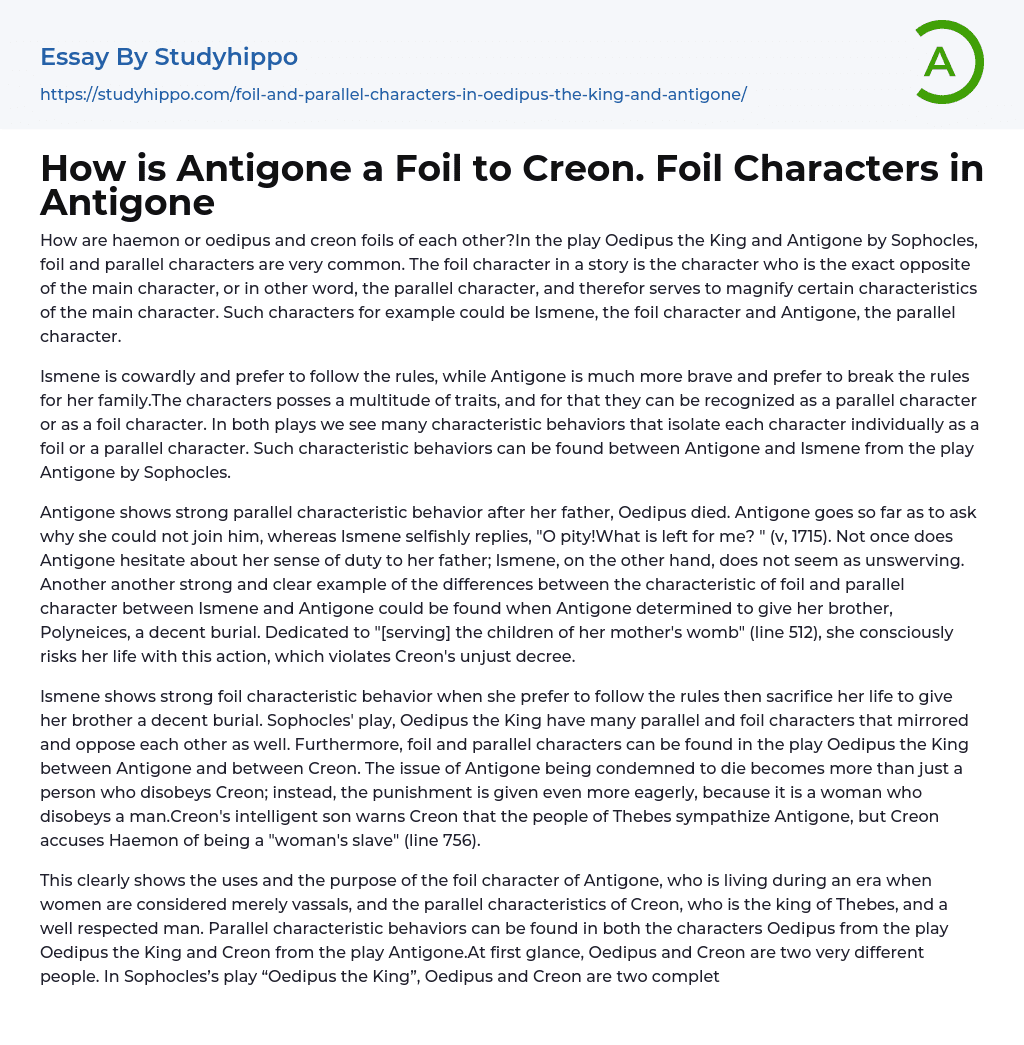

How is Antigone a Foil to Creon. Foil Characters in Antigone Essay Example
How are haemon or oedipus and creon foils of each other?In the play Oedipus the King and Antigone by Sophocles, foil and parallel characters are very common. The foil character in a story is the character who is the exact opposite of the main character, or in other word, the parallel character, and therefor serves to magnify certain characteristics of the main character. Such characters for example could be Ismene, the foil character and Antigone, the parallel character.
Ismene is cowardly and prefer to follow the rules, while Antigone is much more brave and prefer to break the rules for her family.The characters posses a multitude of traits, and for that they can be recognized as a parallel character or as a foil character. In both plays we see many characteristic behaviors that isolate each character individually as a foil o
...r a parallel character. Such characteristic behaviors can be found between Antigone and Ismene from the play Antigone by Sophocles.
Antigone shows strong parallel characteristic behavior after her father, Oedipus died. Antigone goes so far as to ask why she could not join him, whereas Ismene selfishly replies, "O pity!What is left for me? " (v, 1715). Not once does Antigone hesitate about her sense of duty to her father; Ismene, on the other hand, does not seem as unswerving. Another another strong and clear example of the differences between the characteristic of foil and parallel character between Ismene and Antigone could be found when Antigone determined to give her brother, Polyneices, a decent burial. Dedicated to "[serving] the children of her mother's womb" (line 512), she consciously risks her life with this action, whic
violates Creon's unjust decree.
Ismene shows strong foil characteristic behavior when she prefer to follow the rules then sacrifice her life to give her brother a decent burial. Sophocles' play, Oedipus the King have many parallel and foil characters that mirrored and oppose each other as well. Furthermore, foil and parallel characters can be found in the play Oedipus the King between Antigone and between Creon. The issue of Antigone being condemned to die becomes more than just a person who disobeys Creon; instead, the punishment is given even more eagerly, because it is a woman who disobeys a man.Creon's intelligent son warns Creon that the people of Thebes sympathize Antigone, but Creon accuses Haemon of being a "woman's slave" (line 756).
This clearly shows the uses and the purpose of the foil character of Antigone, who is living during an era when women are considered merely vassals, and the parallel characteristics of Creon, who is the king of Thebes, and a well respected man. Parallel characteristic behaviors can be found in both the characters Oedipus from the play Oedipus the King and Creon from the play Antigone.At first glance, Oedipus and Creon are two very different people. In Sophocles’s play “Oedipus the King”, Oedipus and Creon are two completely opposite people. Oedipus is brash and thoughtless, whilst Creon is wise and prudent.
Oedipus becomes arrogant and brash. He accuses Creon and Tiresias of treachery, he says that Creon is “so hungry to overthrow me he sets this wizard on me, this scheming quack, this fortune-teller peddling lies, eyes peeled for his own profit—seer blind in his craft! ”. (v 1756) Even worse however, Oedipus goes
against the gods.This causes them to punish him severely. Creon is the exact antithesis of Oedipus. He thinks before he acts, and that gives him the characteristics behavior of a parallel character.
But as time progresses their personalities and even their fates grow more and more similar. Parallel and foil characters in Sophocles have many purposes and uses in both the plays Oedipus the King and Antigone. Adding motives of foil and parallel characters behind every character, helped make the suspense of the play much stronger.Certain characters and events are mirrored and go through similar sequences in both plays.
The author uses parallel and foil characters as a way to illustrate and help the reader understand the main character characteristic, and the opposite of the main character characteristics, who is the foil character, and therefor serves to magnify certain characteristics of the main character. Both parallel and foil themes and conflicts in Sophocles' plays, Oedipus the King and Antigone, helps create suspense throughout the play.
- First person essays
- 1984 essays
- A Farewell to Arms essays
- A Good Man Is Hard to Find essays
- A Hanging essays
- A Lesson Before Dying essays
- A Long Way Gone essays
- A Rose For Emily essays
- A Separate Peace essays
- A Tale Of Two Cities essays
- A Very Old Man With Enormous Wings essays
- Adventures Of Huckleberry Finn essays
- Alice in Wonderland essays
- All Quiet on The Western Front essays
- Allegory of the Cave essays
- An occurrence at owl creek bridge essays
- Animal Farm essays
- Anthem essays
- Antigone essays
- Arthur Conan Doyle essays
- As I Lay Dying essays
- Atticus Finch essays
- Barn Burning essays
- Battle Royal essays
- Beauty and The Beast essays
- Beloved essays
- Boo Radley essays
- Brave New World essays
- Candide essays
- Castle essays
- Characters In Hamlet essays
- Characters In Romeo And Juliet essays
- Christmas carol essays
- Chronicle of a Death Foretold essays
- Cinderella essays
- Crime and Punishment essays
- Daisy Miller essays
- Death of a Salesman American Dream essays
- Desdemona essays
- Diary Of A Wimpy Kid essays
- Dracula essays
- Dubliners essays
- Emma essays
- Ender'S Game essays
- Ethan Frome essays
- Eveline essays
- Fahrenheit 451 essays
- First-Person Narrative essays
- Fish Cheeks essays
- Frankenstein essays



